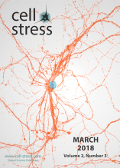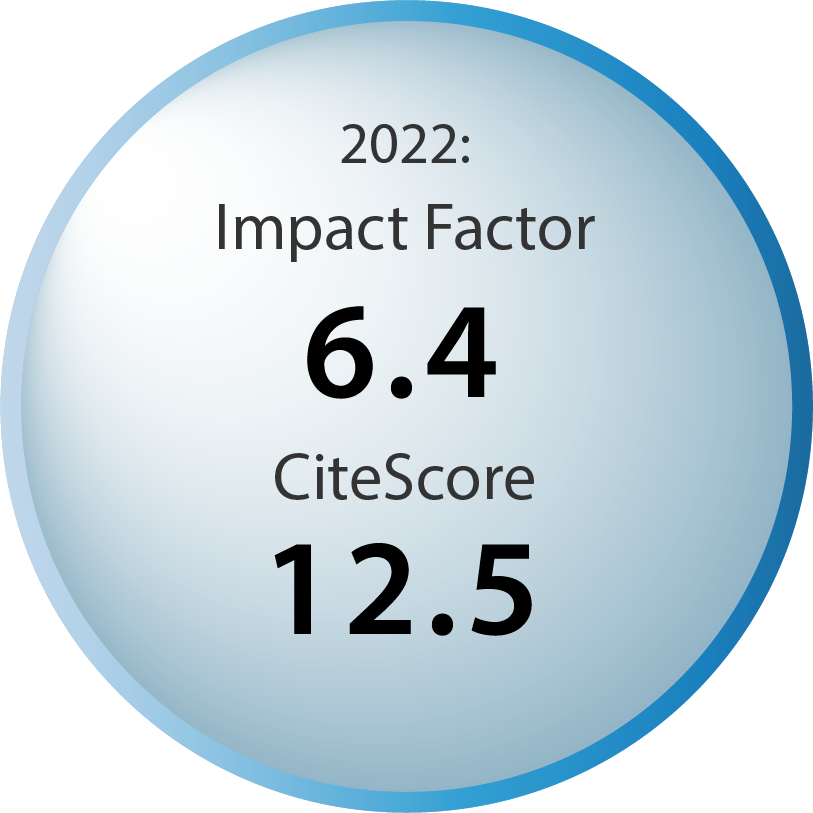Table of contents
Volume 2, Issue 3, pp. 40 - 71, March 2018
Cover: This month in
Cell Stress: Regulation of alternative autophagy and minor intron splicing in neurological disorders. Image depicts mouse spinal cord neuron. Nucleus in teal. Credit: NICHD/S. Jeong. Licensed under a
CC BY 2.0 license. Image modified by
Cell Stress. The cover is published under the
CC BY 4.0 license.
Enlarge issue cover
The emerging role of minor intron splicing in neurological disorders
Daniel Jutzi, Maureen V. Akinyi, Jonas Mechtersheimer, Mikko J. Frilander and Marc-David Ruepp
Reviews |
page 40-54 | 10.15698/cst2018.03.126 | Full text | PDF |
Abstract
Pre-mRNA splicing is an essential step in eukaryotic gene expression. Mutations in cis-acting sequence elements within pre-mRNA molecules or trans-acting factors involved in pre-mRNA processing have both been linked to splicing dysfunction that give rise to a large number of human diseases. These mutations typically affect the major splicing pathway, which excises more than 99% of all introns in humans. However, approximately 700-800 human introns feature divergent intron consensus sequences at their 5′ and 3′ ends and are recognized by a separate pre-mRNA processing machinery denoted as the minor spliceosome. This spliceosome has been studied less than its major counterpart, but has received increasing attention during the last few years as a novel pathomechanistic player on the stage in neurodevelopmental and neurodegenerative diseases. Here, we review the current knowledge on minor spliceosome function and discuss its potential pathomechanistic role and impact in neurodegeneration.
Dram1 regulates DNA damage-induced alternative autophagy
Meruna Nagata, Satoko Arakawa, Hirofumi Yamaguchi, Satoru Torii, Hazuki Endo, Masatsune Tsujioka, Shinya Honda, Yuya Nishida, Akimitsu Konishi, Shigeomi Shimizu
Research Articles |
page 55-65 | 10.15698/cst2018.03.127 | Full text | PDF |
Abstract
Autophagy is an evolutionarily conserved process that degrades subcellular constituents. Mammalian cells undergo two types of autophagy; Atg5-dependent conventional autophagy and Atg5-independent alternative autophagy, and the molecules required for the latter type of autophagy are largely unknown. In this study, we analyzed the molecular mechanisms of genotoxic stress-induced alternative autophagy, and identified the essential role of p53 and damage-regulated autophagy modulator (Dram1). Dram1 was sufficient to induce alternative autophagy. In the mechanism of alternative autophagy, Dram1 functions in the closure of isolation membranes downstream of p53. These findings indicate that Dram1 plays a pivotal role in genotoxic stress-induced alternative autophagy.
A new way to regulate inflammation: selective autophagic degradation of IKKγ mediated by ANGPTL8
Yu Zhang, Ling Zheng and Kun Huang
Microreviews |
page 66-68 | 10.15698/cst2018.03.128 | Full text | PDF |
Abstract
Transcription factor nuclear factor-κB (NF-κB) plays pivotal roles in the regulation of inflammation and immunity. However, the precise mechanism of NF-κB activation is not fully elucidated. We recently found that Angiopoietin like protein 8 (ANGPTL8, also known as Lipasin, RIFL, TD26 or C19orf80), which is a previously identified secreted metabolic regulator, also can work intracellularly as a negative feedback inhibitor of NF-κB activation. Mechanistically, ANGPTL8 is induced by TNFα stimulation, a classic inducer for NF-κB activation; then, the intracellular ANGPTL8 self-associates via its N-terminal region and interacts with Sequestosome-1 (p62/SQSTM1). The resulting ANGPTL8-p62 aggregates work as a platform in the recruitment and autophagic degradation of IκB kinase gamma (IKKγ/NEMO). Consistently, in patients diagnosed with infectious diseases, enhanced circulating ANGPTL8 levels were detected. These findings suggest a new role for selective autophagy in the regulation of signal transduction and inflammation.
Therapeutic potential of DNA methyltransferase inhibitors with immune checkpoint inhibitor therapy in breast cancer
Na Luo, Ayaka Sugiura and Justin M. Balko
Microreviews |
page 69-71 | 10.15698/cst2018.03.129 | Full text | PDF |
Abstract
Immune checkpoint inhibitor (ICI) therapy has changed the landscape of cancer treatment, particularly for high-mutation burden cancers. However, ICI therapy has thus far demonstrated limited efficacy in breast cancers, where tumor mutation rates are intermediate. Nonetheless, because of limited but positive signals in early trials, combinations of therapies to enhance anti-tumor immunity, and thus response to ICIs in breast cancer, are actively being sought. Our laboratory recently found that guadecitabine, a next-generation DNA methyltransferase inhibitor (DMTi), potentiated cytotoxic CD8+ T cell responses in breast cancer, which appeared to occur by the following mechanisms: (1) DMTi treatment hypomethylated and up-regulated both baseline and IFN-γ-induced MHC-I expression, thereby enhancing antigen presentation capacity, (2) DMTi treatment increased Cxcr3 ligands/chemokines (i.e., Cxcl9, Cxcl10, and Cxcl11) expression and recruited cytotoxic CD8+ T cells into the tumors and (3) DMTi treatment activated NFκB signaling, presumably through the expression of endogenous retroviral (ERV) sequences in tumor cells, initiating an innate response observed in other solid tumor types [Luo et al., Nat Commun 9(1):248]. Most importantly, DMTi treatment primed breast cancer and improved responses to anti-PD-L1 therapy.



